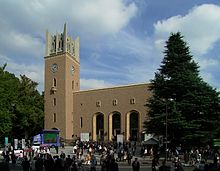Takadanobaba Railway Station
| Takadanobaba Railway Station | |
|---|---|
|
Yamanote Line Platform
|
|
| Data | |
| Design | Through station |
| Platform tracks | 6 (2 per company) |
| opening |
|
| location | |
| City / municipality | Shinjuku |
| prefecture | Tokyo |
| Country | Japan |
| Coordinates | 35 ° 42 '44 " N , 139 ° 42' 14" E |
| Railway lines | |
|
|
|
| List of train stations in Japan | |
The Takadanobaba Station ( Jap. 高田馬場駅 , Takadanobaba-eki ) is located in Shinjuku in Tokyo , Japan . The Kanda River ( 神 田 川 , Kandagawa ) flows about 100 m north of the station in an east-west direction.
history
- September 15, 1910: The station opens as a station on the Yamanote Line
- April 16, 1927: The Seibu Tetsudō station opens
- April 13, 1945: The station is destroyed in a fire caused by an air raid during World War II
- December 23, 1964: The Tōzai Line station opens
- 1998: The Seibu Tetsudō station is completely renovated. The work will officially end on March 10, 2001
- March 1, 2003: The Yamanote line receives the title melody from Astro Boy as the station melody
- April 1, 2004: The privatization of Tozai Line does this become the property of Tōkyō Metro about
- April 5, 2008: At the Waseda exit, work on a mural with characters by Osamu Tezuka is finished
Type of construction and tracks
The Takadanobaba station is built in the most common design of a station in the form of a through station. The tracks of the JR East Yamanote Line and the Seibu Shinjuku Line run above ground in a north-south direction and serve a train station with 5 platforms. The Yamanote line drives to a single central platform . The Yamanote Line trains run from Platform 1. The remaining three above-ground platforms are used by the Shinjuku line. Trains to Hajima and Hon-Kawagoe run from platform 3, and trains to Shinjuku from platform 5. Platform 4 is only used as an additional exit during the week during the morning rush hour.
The two tracks of the Tōzai line of the Tōkyō Metro run underground in an east-west direction. These are used from two side platforms. Trains to Ōtemachi and Nishi-Funabashi depart from platform 1, and trains to Nakano from platform 2 .
JR East and Seibu Tetsudō platforms
| 1 | ▉ Yamanote Line | Ikebukuro • Ueno • Tokyo |
| 2 | ▉ Yamanote Line | Shinjuku • Shibuya • Shinagawa |
| 3 | ▉ Shinjuku line | Tokorozawa • Hon-Kawagoe • Haijima |
| 4th | ▉ Shinjuku line | only open during the week during rush hour as an additional exit |
| 5 | ▉ Shinjuku line | Seibu Shinjuku |
Platforms of the Tōkyō Metro
| 1 |
|
Iidabashi (T-06) • Ōtemachi (T-09) • Nishi-Funabashi (T-23) |
| 2 |
|
Ochiai (T-02) • Nakano (T-01) |
Lines
The station is served by three companies with a total of three lines. These are the Yamanote Line of the JR East, the Tōzai Line of the Tōkyō Metro and the Shinjuku Line of the Seibu Tetsudō. The colors of the Yamanote line and the Tōzai line used in the table below correspond to the color of the line used by the respective society.
|
←
|
Lines |
→
|
||
|---|---|---|---|---|
| Shin-Ōkubo |
JR East |
Mejiro | ||
| Ochiai (T-02) |
Tōkyō Metro |
Waseda (T-04) | ||
| Seibu Shinjuku |
Seibu Tetsudō |
Shimo-Ochiai | ||
Station melody
Since April 1, 2003, the theme tune of the anime Astro Boy, which was broadcast on Japanese television from 1963, based on the manga of the same name by Osamu Tezuka, has been played on the platforms of the Yamanote Line . This was chosen at this point because the manga story begins in 2003.
Surroundings
The Waseda University , the Gakushūin Women's University ( 学習 院 女子 大学 , Gakushūin joshi daigaku ), the Fuji University of Tōkyō ( 東京 富士 大学 , Tōkyō fuji daigaku ) and the headquarters of Taishō Seiyaku ( 薬. 正 製 ) are close to the train station 株式会社 , Taishō Seiyaku Kabushiki kaisha ).
use
In 2014, the station was used by an average of 200,195 passengers per day, making it 12th of over 900 on the list of the most frequently used stations of the JR East in 2014. The Tōzai line of the Tōkyō Metro was used at the station by an average of 187,458 passengers a day in 2014. The station ranks 9th among the most used stations on the Tōkyō Metro. The Shinjuku Line station is used by an average of 289,810 passengers a day. The station is the third most used station of the Seibu Tetsudō in 2014.
Footnotes and individual references
- ↑ Passengers boarding in Takadanobaba. Calculation from sold single, collective and monthly tickets.
- ↑ http://www.jreast.co.jp/habenger/index.html Source: JR East, rank 12
- ↑ http://www.tokyometro.jp/corporate/enterprise/zügeger_rail/transportation/züge/index.html Source: Tokyo Metro, rank 9
- ↑ Passenger numbers ( memento of March 8, 2016 in the Internet Archive ) Source: Seibu Tetsudō, rank 2

